7AAD0049 Operations Research Report: Decision-Making Analysis
VerifiedAdded on 2022/12/30
|15
|2985
|64
Report
AI Summary
This report provides an in-depth analysis of decision-making within the field of operations research. It explores the importance of decision-making in effective operations management, highlighting how analytical methods are crucial for solving complex business problems. The report delves into various decision-making scenarios, including those under uncertainty, risk, and certainty, and examines methods such as the Maximin Criterion, Fuzzy Method, and Robust Optimization. It also discusses the application of operations research tools like decision trees and the Markov decision process to improve business outcomes. The report emphasizes the interconnectedness of operations management and decision-making, showcasing how strategic frameworks and analytical tools can enhance efficiency, maximize profits, and ensure the sustainability of business operations. The paper references key concepts, theories, and practical applications to provide a comprehensive overview of the subject.
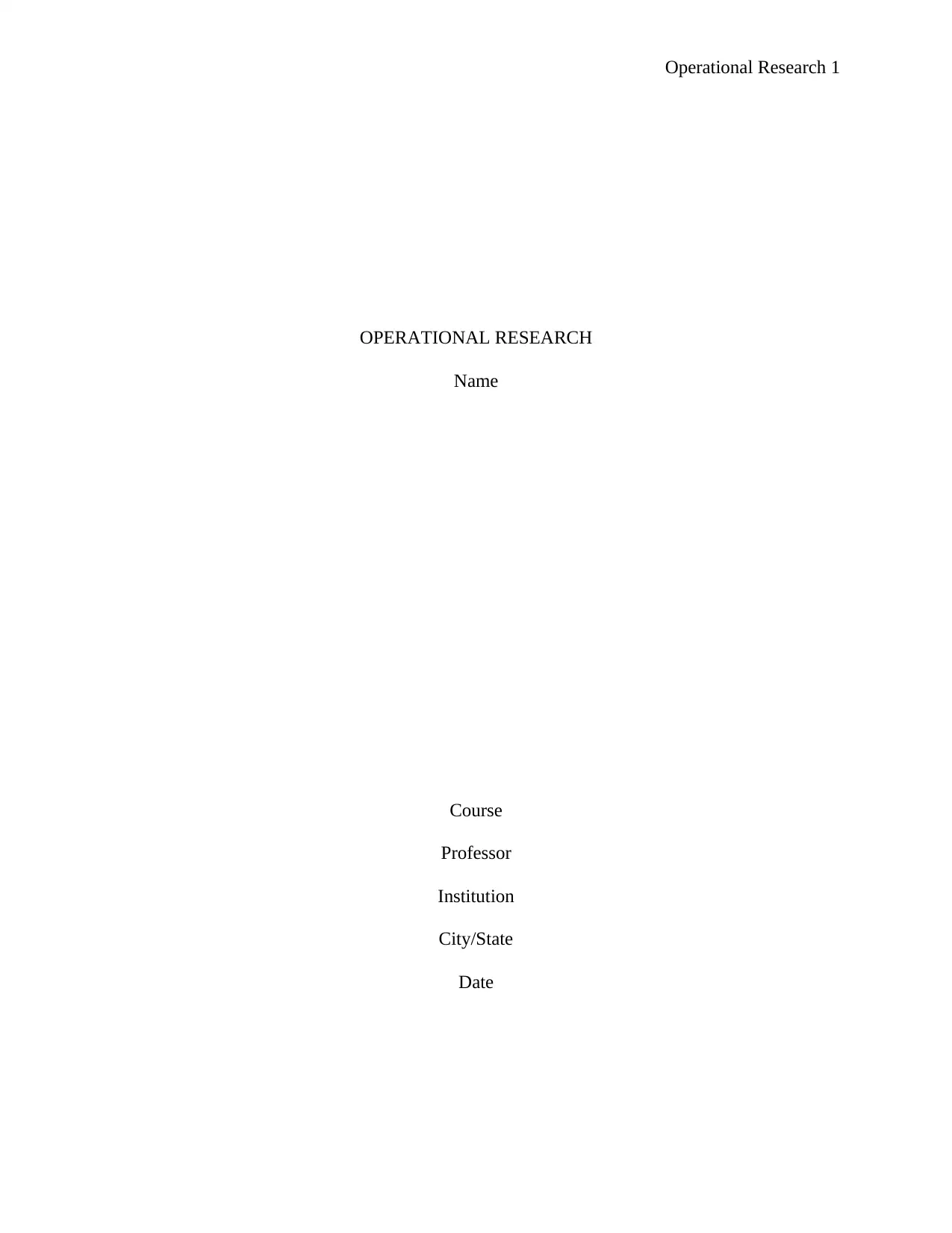
Operational Research 1
OPERATIONAL RESEARCH
Name
Course
Professor
Institution
City/State
Date
OPERATIONAL RESEARCH
Name
Course
Professor
Institution
City/State
Date
Paraphrase This Document
Need a fresh take? Get an instant paraphrase of this document with our AI Paraphraser

Operational Research 2
Executive Summary
The paper covers the effectiveness of operations management. It illustrates how a
decision is a primary factor in contributing to effective operation management. Decision making
is a primary driver in solving problems with the use of analytical methods. The methods are
applied by organizations to enhance control. Several activities take place in operations research
such as breaking down of problems into segments and then solving them in steps by the aid of
mathematical analysis. Organizations have adopted operations research as a model to address
complex issues related to business operations
The decisions influence the various ways that have been incorporated into business
management that managers make. Managers of multiple businesses are required to make
improved decisions regarding transactions since it is essential in shaping the corporate image of a
company and ensuring that the business is run efficiently with the available resources.
Executive Summary
The paper covers the effectiveness of operations management. It illustrates how a
decision is a primary factor in contributing to effective operation management. Decision making
is a primary driver in solving problems with the use of analytical methods. The methods are
applied by organizations to enhance control. Several activities take place in operations research
such as breaking down of problems into segments and then solving them in steps by the aid of
mathematical analysis. Organizations have adopted operations research as a model to address
complex issues related to business operations
The decisions influence the various ways that have been incorporated into business
management that managers make. Managers of multiple businesses are required to make
improved decisions regarding transactions since it is essential in shaping the corporate image of a
company and ensuring that the business is run efficiently with the available resources.
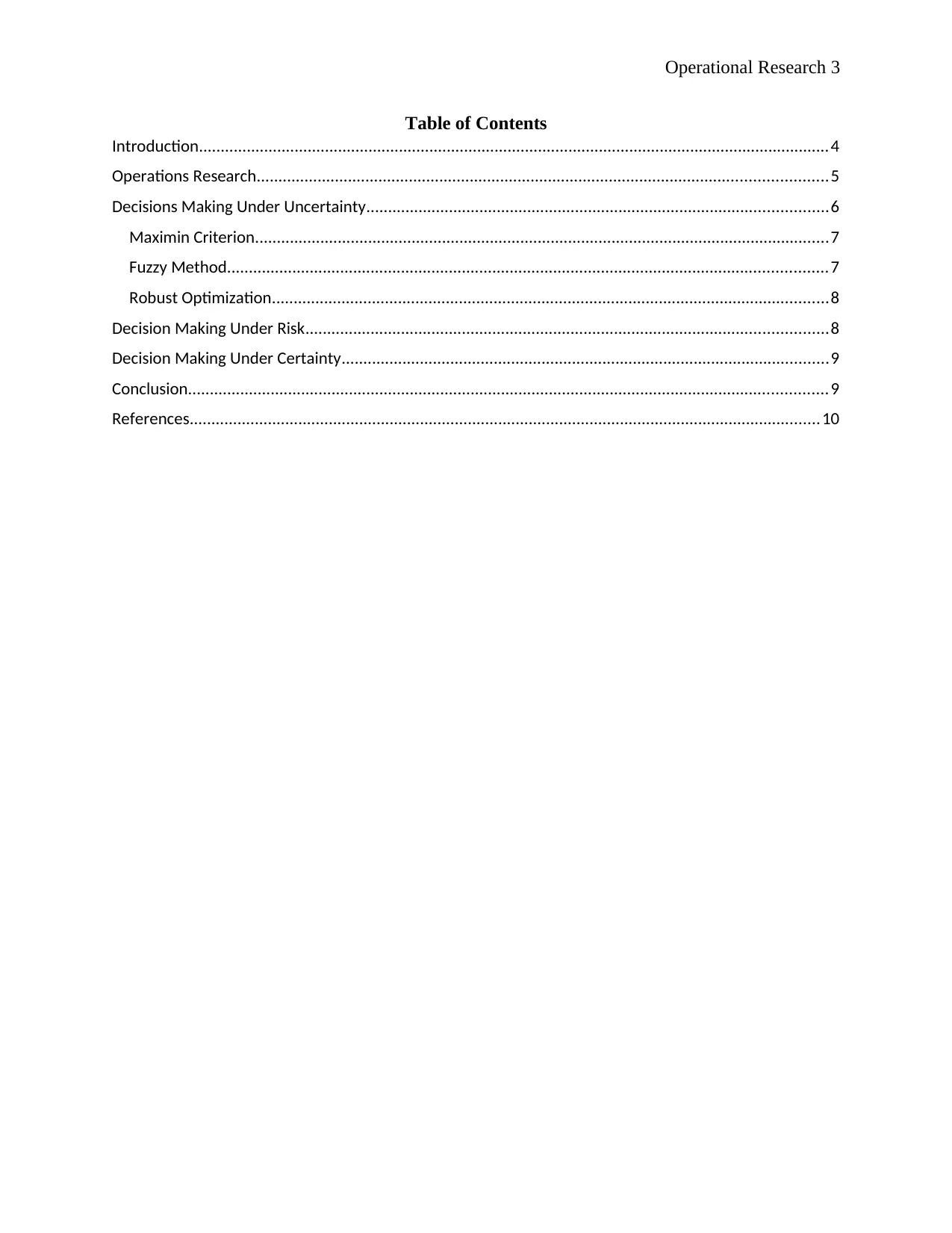
Operational Research 3
Table of Contents
Introduction.................................................................................................................................................4
Operations Research...................................................................................................................................5
Decisions Making Under Uncertainty..........................................................................................................6
Maximin Criterion....................................................................................................................................7
Fuzzy Method..........................................................................................................................................7
Robust Optimization................................................................................................................................8
Decision Making Under Risk........................................................................................................................8
Decision Making Under Certainty................................................................................................................9
Conclusion...................................................................................................................................................9
References.................................................................................................................................................10
Table of Contents
Introduction.................................................................................................................................................4
Operations Research...................................................................................................................................5
Decisions Making Under Uncertainty..........................................................................................................6
Maximin Criterion....................................................................................................................................7
Fuzzy Method..........................................................................................................................................7
Robust Optimization................................................................................................................................8
Decision Making Under Risk........................................................................................................................8
Decision Making Under Certainty................................................................................................................9
Conclusion...................................................................................................................................................9
References.................................................................................................................................................10
⊘ This is a preview!⊘
Do you want full access?
Subscribe today to unlock all pages.

Trusted by 1+ million students worldwide
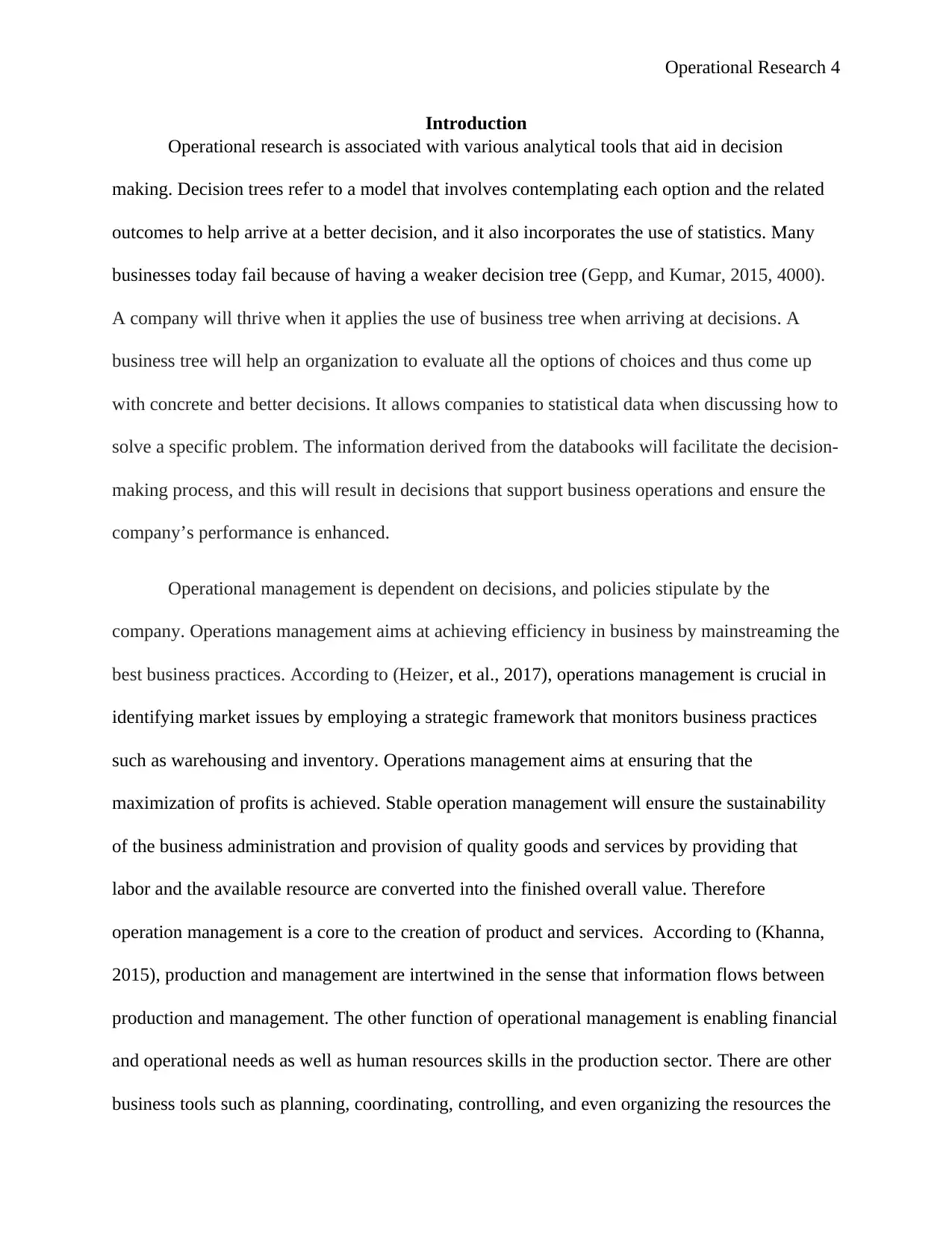
Operational Research 4
Introduction
Operational research is associated with various analytical tools that aid in decision
making. Decision trees refer to a model that involves contemplating each option and the related
outcomes to help arrive at a better decision, and it also incorporates the use of statistics. Many
businesses today fail because of having a weaker decision tree (Gepp, and Kumar, 2015, 4000).
A company will thrive when it applies the use of business tree when arriving at decisions. A
business tree will help an organization to evaluate all the options of choices and thus come up
with concrete and better decisions. It allows companies to statistical data when discussing how to
solve a specific problem. The information derived from the databooks will facilitate the decision-
making process, and this will result in decisions that support business operations and ensure the
company’s performance is enhanced.
Operational management is dependent on decisions, and policies stipulate by the
company. Operations management aims at achieving efficiency in business by mainstreaming the
best business practices. According to (Heizer, et al., 2017), operations management is crucial in
identifying market issues by employing a strategic framework that monitors business practices
such as warehousing and inventory. Operations management aims at ensuring that the
maximization of profits is achieved. Stable operation management will ensure the sustainability
of the business administration and provision of quality goods and services by providing that
labor and the available resource are converted into the finished overall value. Therefore
operation management is a core to the creation of product and services. According to (Khanna,
2015), production and management are intertwined in the sense that information flows between
production and management. The other function of operational management is enabling financial
and operational needs as well as human resources skills in the production sector. There are other
business tools such as planning, coordinating, controlling, and even organizing the resources the
Introduction
Operational research is associated with various analytical tools that aid in decision
making. Decision trees refer to a model that involves contemplating each option and the related
outcomes to help arrive at a better decision, and it also incorporates the use of statistics. Many
businesses today fail because of having a weaker decision tree (Gepp, and Kumar, 2015, 4000).
A company will thrive when it applies the use of business tree when arriving at decisions. A
business tree will help an organization to evaluate all the options of choices and thus come up
with concrete and better decisions. It allows companies to statistical data when discussing how to
solve a specific problem. The information derived from the databooks will facilitate the decision-
making process, and this will result in decisions that support business operations and ensure the
company’s performance is enhanced.
Operational management is dependent on decisions, and policies stipulate by the
company. Operations management aims at achieving efficiency in business by mainstreaming the
best business practices. According to (Heizer, et al., 2017), operations management is crucial in
identifying market issues by employing a strategic framework that monitors business practices
such as warehousing and inventory. Operations management aims at ensuring that the
maximization of profits is achieved. Stable operation management will ensure the sustainability
of the business administration and provision of quality goods and services by providing that
labor and the available resource are converted into the finished overall value. Therefore
operation management is a core to the creation of product and services. According to (Khanna,
2015), production and management are intertwined in the sense that information flows between
production and management. The other function of operational management is enabling financial
and operational needs as well as human resources skills in the production sector. There are other
business tools such as planning, coordinating, controlling, and even organizing the resources the
Paraphrase This Document
Need a fresh take? Get an instant paraphrase of this document with our AI Paraphraser
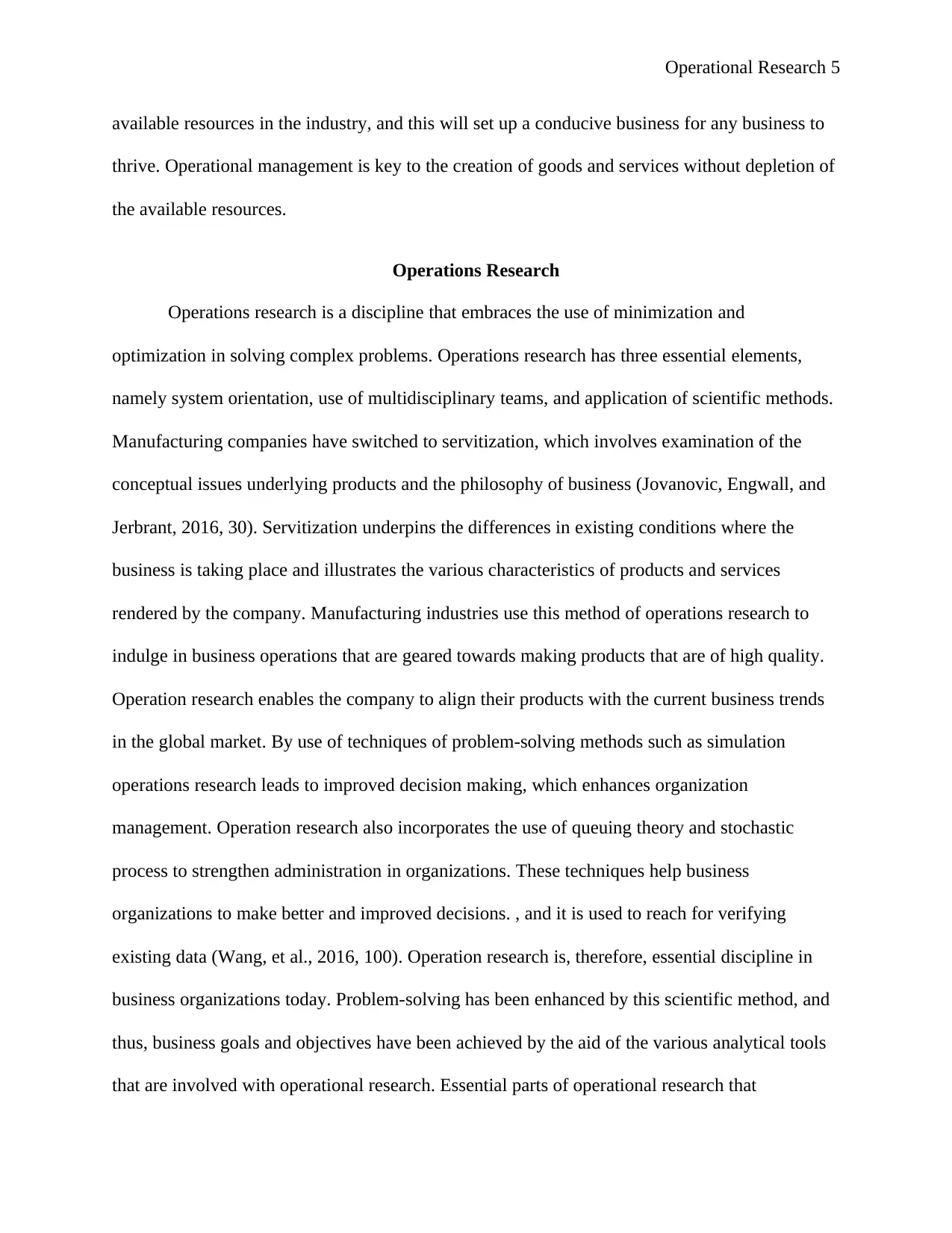
Operational Research 5
available resources in the industry, and this will set up a conducive business for any business to
thrive. Operational management is key to the creation of goods and services without depletion of
the available resources.
Operations Research
Operations research is a discipline that embraces the use of minimization and
optimization in solving complex problems. Operations research has three essential elements,
namely system orientation, use of multidisciplinary teams, and application of scientific methods.
Manufacturing companies have switched to servitization, which involves examination of the
conceptual issues underlying products and the philosophy of business (Jovanovic, Engwall, and
Jerbrant, 2016, 30). Servitization underpins the differences in existing conditions where the
business is taking place and illustrates the various characteristics of products and services
rendered by the company. Manufacturing industries use this method of operations research to
indulge in business operations that are geared towards making products that are of high quality.
Operation research enables the company to align their products with the current business trends
in the global market. By use of techniques of problem-solving methods such as simulation
operations research leads to improved decision making, which enhances organization
management. Operation research also incorporates the use of queuing theory and stochastic
process to strengthen administration in organizations. These techniques help business
organizations to make better and improved decisions. , and it is used to reach for verifying
existing data (Wang, et al., 2016, 100). Operation research is, therefore, essential discipline in
business organizations today. Problem-solving has been enhanced by this scientific method, and
thus, business goals and objectives have been achieved by the aid of the various analytical tools
that are involved with operational research. Essential parts of operational research that
available resources in the industry, and this will set up a conducive business for any business to
thrive. Operational management is key to the creation of goods and services without depletion of
the available resources.
Operations Research
Operations research is a discipline that embraces the use of minimization and
optimization in solving complex problems. Operations research has three essential elements,
namely system orientation, use of multidisciplinary teams, and application of scientific methods.
Manufacturing companies have switched to servitization, which involves examination of the
conceptual issues underlying products and the philosophy of business (Jovanovic, Engwall, and
Jerbrant, 2016, 30). Servitization underpins the differences in existing conditions where the
business is taking place and illustrates the various characteristics of products and services
rendered by the company. Manufacturing industries use this method of operations research to
indulge in business operations that are geared towards making products that are of high quality.
Operation research enables the company to align their products with the current business trends
in the global market. By use of techniques of problem-solving methods such as simulation
operations research leads to improved decision making, which enhances organization
management. Operation research also incorporates the use of queuing theory and stochastic
process to strengthen administration in organizations. These techniques help business
organizations to make better and improved decisions. , and it is used to reach for verifying
existing data (Wang, et al., 2016, 100). Operation research is, therefore, essential discipline in
business organizations today. Problem-solving has been enhanced by this scientific method, and
thus, business goals and objectives have been achieved by the aid of the various analytical tools
that are involved with operational research. Essential parts of operational research that
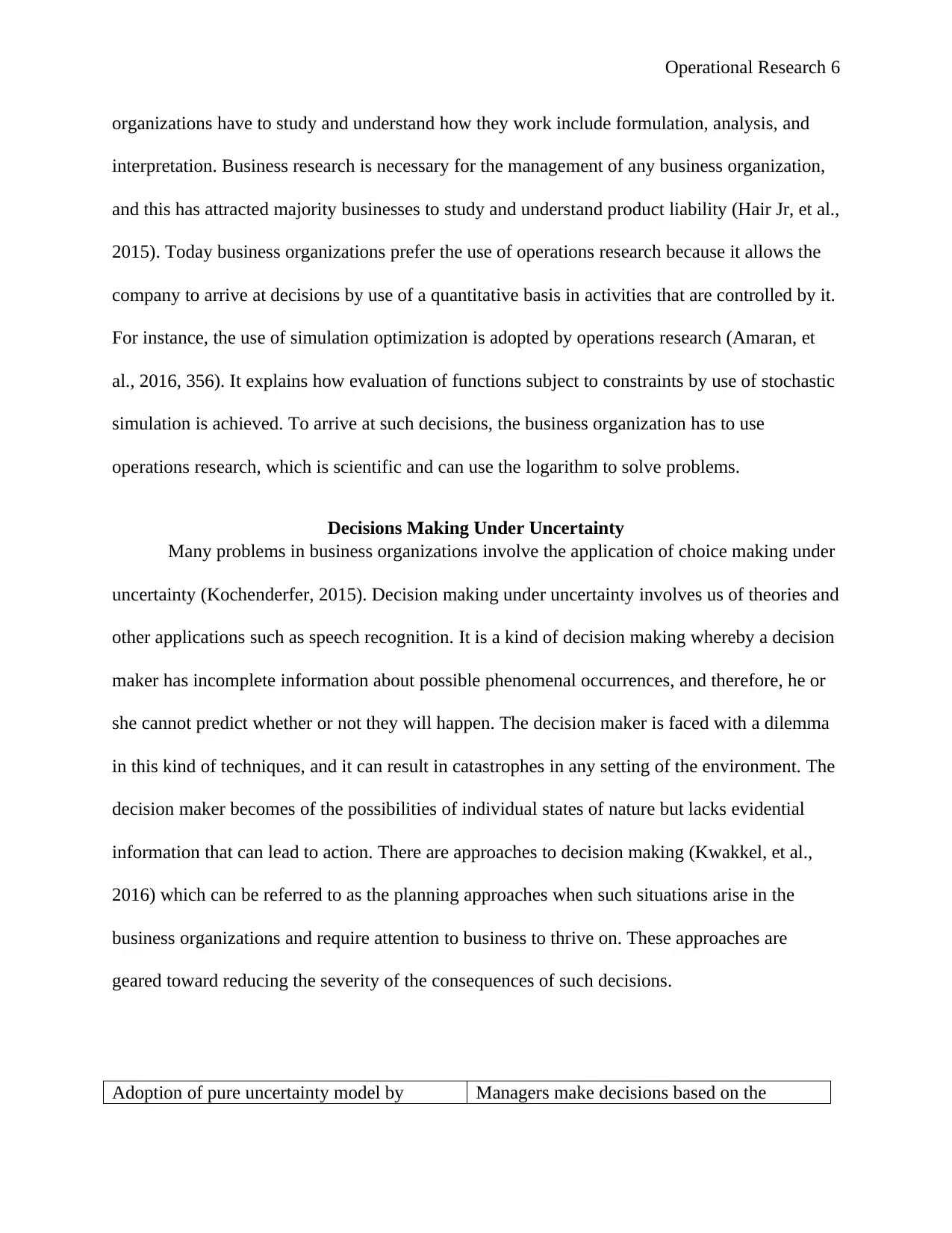
Operational Research 6
organizations have to study and understand how they work include formulation, analysis, and
interpretation. Business research is necessary for the management of any business organization,
and this has attracted majority businesses to study and understand product liability (Hair Jr, et al.,
2015). Today business organizations prefer the use of operations research because it allows the
company to arrive at decisions by use of a quantitative basis in activities that are controlled by it.
For instance, the use of simulation optimization is adopted by operations research (Amaran, et
al., 2016, 356). It explains how evaluation of functions subject to constraints by use of stochastic
simulation is achieved. To arrive at such decisions, the business organization has to use
operations research, which is scientific and can use the logarithm to solve problems.
Decisions Making Under Uncertainty
Many problems in business organizations involve the application of choice making under
uncertainty (Kochenderfer, 2015). Decision making under uncertainty involves us of theories and
other applications such as speech recognition. It is a kind of decision making whereby a decision
maker has incomplete information about possible phenomenal occurrences, and therefore, he or
she cannot predict whether or not they will happen. The decision maker is faced with a dilemma
in this kind of techniques, and it can result in catastrophes in any setting of the environment. The
decision maker becomes of the possibilities of individual states of nature but lacks evidential
information that can lead to action. There are approaches to decision making (Kwakkel, et al.,
2016) which can be referred to as the planning approaches when such situations arise in the
business organizations and require attention to business to thrive on. These approaches are
geared toward reducing the severity of the consequences of such decisions.
Adoption of pure uncertainty model by Managers make decisions based on the
organizations have to study and understand how they work include formulation, analysis, and
interpretation. Business research is necessary for the management of any business organization,
and this has attracted majority businesses to study and understand product liability (Hair Jr, et al.,
2015). Today business organizations prefer the use of operations research because it allows the
company to arrive at decisions by use of a quantitative basis in activities that are controlled by it.
For instance, the use of simulation optimization is adopted by operations research (Amaran, et
al., 2016, 356). It explains how evaluation of functions subject to constraints by use of stochastic
simulation is achieved. To arrive at such decisions, the business organization has to use
operations research, which is scientific and can use the logarithm to solve problems.
Decisions Making Under Uncertainty
Many problems in business organizations involve the application of choice making under
uncertainty (Kochenderfer, 2015). Decision making under uncertainty involves us of theories and
other applications such as speech recognition. It is a kind of decision making whereby a decision
maker has incomplete information about possible phenomenal occurrences, and therefore, he or
she cannot predict whether or not they will happen. The decision maker is faced with a dilemma
in this kind of techniques, and it can result in catastrophes in any setting of the environment. The
decision maker becomes of the possibilities of individual states of nature but lacks evidential
information that can lead to action. There are approaches to decision making (Kwakkel, et al.,
2016) which can be referred to as the planning approaches when such situations arise in the
business organizations and require attention to business to thrive on. These approaches are
geared toward reducing the severity of the consequences of such decisions.
Adoption of pure uncertainty model by Managers make decisions based on the
⊘ This is a preview!⊘
Do you want full access?
Subscribe today to unlock all pages.

Trusted by 1+ million students worldwide
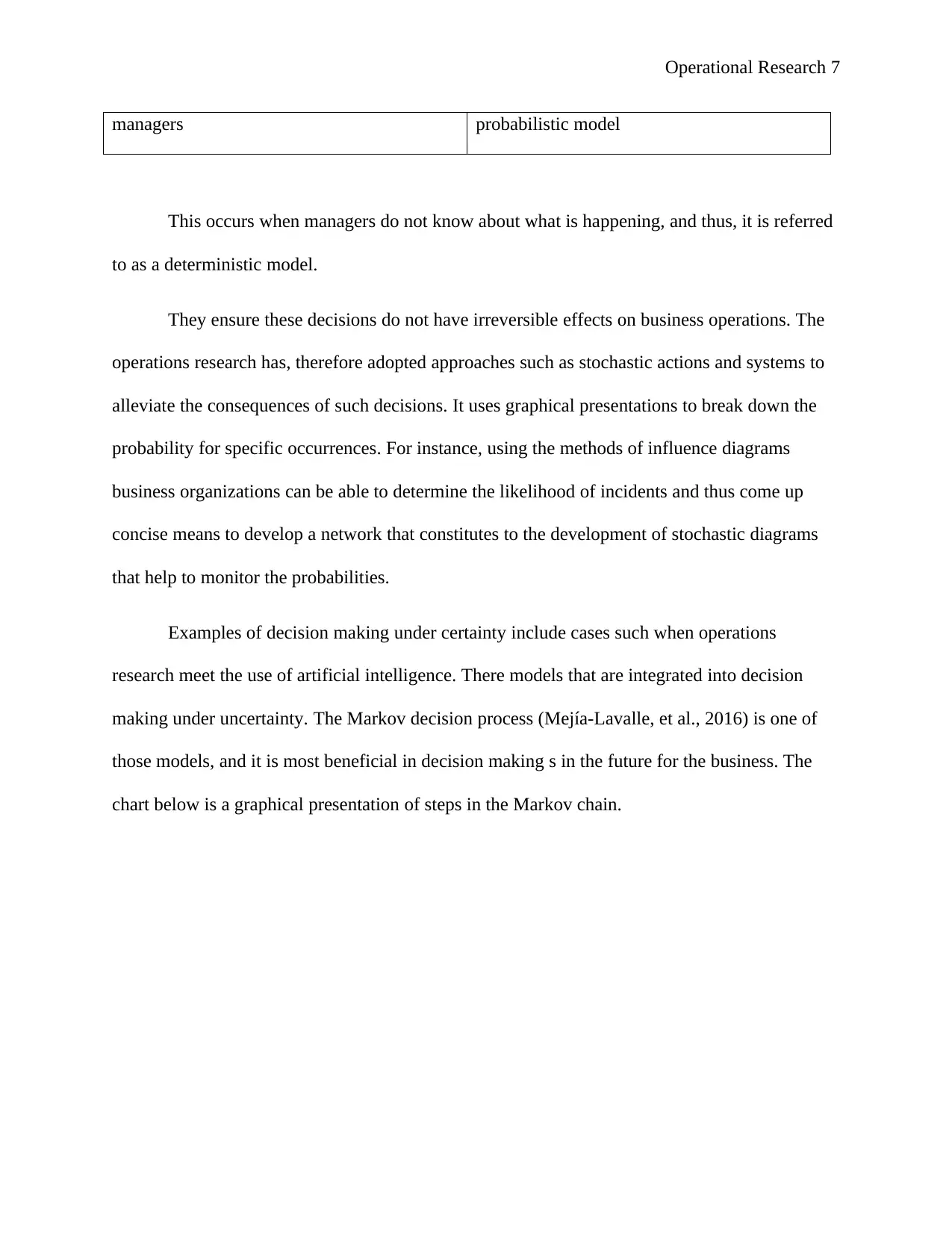
Operational Research 7
managers probabilistic model
This occurs when managers do not know about what is happening, and thus, it is referred
to as a deterministic model.
They ensure these decisions do not have irreversible effects on business operations. The
operations research has, therefore adopted approaches such as stochastic actions and systems to
alleviate the consequences of such decisions. It uses graphical presentations to break down the
probability for specific occurrences. For instance, using the methods of influence diagrams
business organizations can be able to determine the likelihood of incidents and thus come up
concise means to develop a network that constitutes to the development of stochastic diagrams
that help to monitor the probabilities.
Examples of decision making under certainty include cases such when operations
research meet the use of artificial intelligence. There models that are integrated into decision
making under uncertainty. The Markov decision process (Mejía-Lavalle, et al., 2016) is one of
those models, and it is most beneficial in decision making s in the future for the business. The
chart below is a graphical presentation of steps in the Markov chain.
managers probabilistic model
This occurs when managers do not know about what is happening, and thus, it is referred
to as a deterministic model.
They ensure these decisions do not have irreversible effects on business operations. The
operations research has, therefore adopted approaches such as stochastic actions and systems to
alleviate the consequences of such decisions. It uses graphical presentations to break down the
probability for specific occurrences. For instance, using the methods of influence diagrams
business organizations can be able to determine the likelihood of incidents and thus come up
concise means to develop a network that constitutes to the development of stochastic diagrams
that help to monitor the probabilities.
Examples of decision making under certainty include cases such when operations
research meet the use of artificial intelligence. There models that are integrated into decision
making under uncertainty. The Markov decision process (Mejía-Lavalle, et al., 2016) is one of
those models, and it is most beneficial in decision making s in the future for the business. The
chart below is a graphical presentation of steps in the Markov chain.
Paraphrase This Document
Need a fresh take? Get an instant paraphrase of this document with our AI Paraphraser
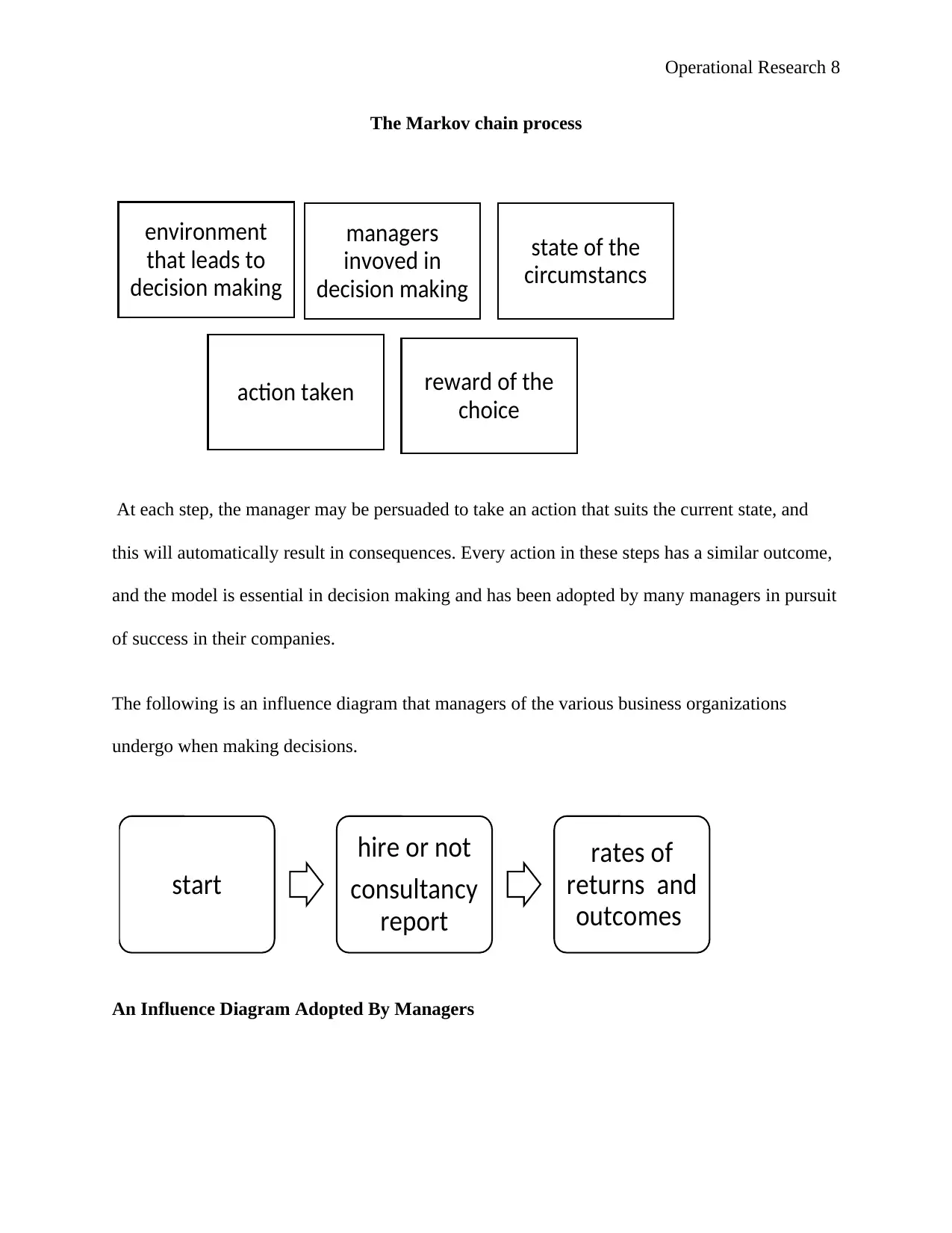
Operational Research 8
The Markov chain process
At each step, the manager may be persuaded to take an action that suits the current state, and
this will automatically result in consequences. Every action in these steps has a similar outcome,
and the model is essential in decision making and has been adopted by many managers in pursuit
of success in their companies.
The following is an influence diagram that managers of the various business organizations
undergo when making decisions.
An Influence Diagram Adopted By Managers
environment
that leads to
decision making
managers
invoved in
decision making
state of the
circumstancs
action taken reward of the
choice
start
hire or not
consultancy
report
rates of
returns and
outcomes
The Markov chain process
At each step, the manager may be persuaded to take an action that suits the current state, and
this will automatically result in consequences. Every action in these steps has a similar outcome,
and the model is essential in decision making and has been adopted by many managers in pursuit
of success in their companies.
The following is an influence diagram that managers of the various business organizations
undergo when making decisions.
An Influence Diagram Adopted By Managers
environment
that leads to
decision making
managers
invoved in
decision making
state of the
circumstancs
action taken reward of the
choice
start
hire or not
consultancy
report
rates of
returns and
outcomes
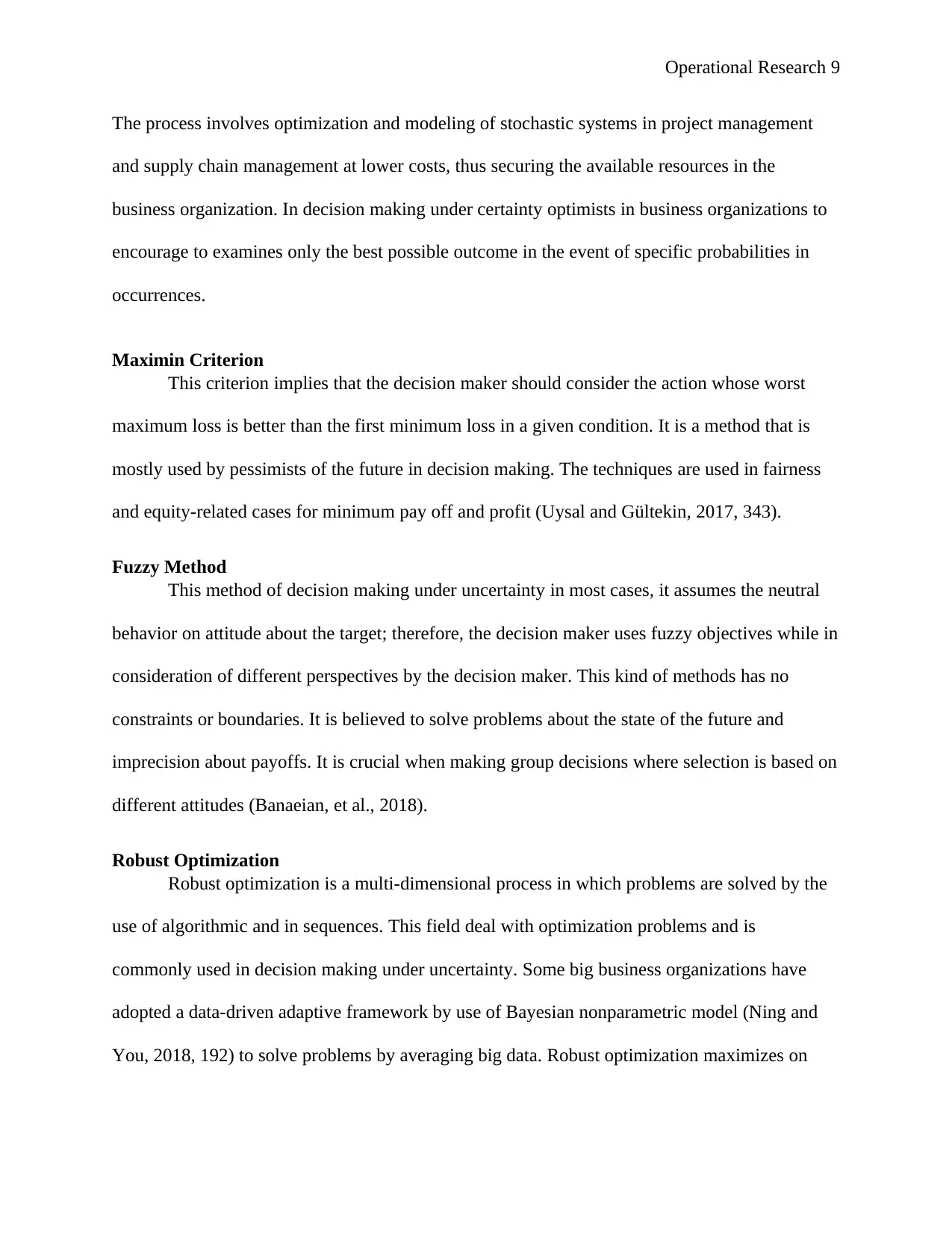
Operational Research 9
The process involves optimization and modeling of stochastic systems in project management
and supply chain management at lower costs, thus securing the available resources in the
business organization. In decision making under certainty optimists in business organizations to
encourage to examines only the best possible outcome in the event of specific probabilities in
occurrences.
Maximin Criterion
This criterion implies that the decision maker should consider the action whose worst
maximum loss is better than the first minimum loss in a given condition. It is a method that is
mostly used by pessimists of the future in decision making. The techniques are used in fairness
and equity-related cases for minimum pay off and profit (Uysal and Gültekin, 2017, 343).
Fuzzy Method
This method of decision making under uncertainty in most cases, it assumes the neutral
behavior on attitude about the target; therefore, the decision maker uses fuzzy objectives while in
consideration of different perspectives by the decision maker. This kind of methods has no
constraints or boundaries. It is believed to solve problems about the state of the future and
imprecision about payoffs. It is crucial when making group decisions where selection is based on
different attitudes (Banaeian, et al., 2018).
Robust Optimization
Robust optimization is a multi-dimensional process in which problems are solved by the
use of algorithmic and in sequences. This field deal with optimization problems and is
commonly used in decision making under uncertainty. Some big business organizations have
adopted a data-driven adaptive framework by use of Bayesian nonparametric model (Ning and
You, 2018, 192) to solve problems by averaging big data. Robust optimization maximizes on
The process involves optimization and modeling of stochastic systems in project management
and supply chain management at lower costs, thus securing the available resources in the
business organization. In decision making under certainty optimists in business organizations to
encourage to examines only the best possible outcome in the event of specific probabilities in
occurrences.
Maximin Criterion
This criterion implies that the decision maker should consider the action whose worst
maximum loss is better than the first minimum loss in a given condition. It is a method that is
mostly used by pessimists of the future in decision making. The techniques are used in fairness
and equity-related cases for minimum pay off and profit (Uysal and Gültekin, 2017, 343).
Fuzzy Method
This method of decision making under uncertainty in most cases, it assumes the neutral
behavior on attitude about the target; therefore, the decision maker uses fuzzy objectives while in
consideration of different perspectives by the decision maker. This kind of methods has no
constraints or boundaries. It is believed to solve problems about the state of the future and
imprecision about payoffs. It is crucial when making group decisions where selection is based on
different attitudes (Banaeian, et al., 2018).
Robust Optimization
Robust optimization is a multi-dimensional process in which problems are solved by the
use of algorithmic and in sequences. This field deal with optimization problems and is
commonly used in decision making under uncertainty. Some big business organizations have
adopted a data-driven adaptive framework by use of Bayesian nonparametric model (Ning and
You, 2018, 192) to solve problems by averaging big data. Robust optimization maximizes on
⊘ This is a preview!⊘
Do you want full access?
Subscribe today to unlock all pages.

Trusted by 1+ million students worldwide
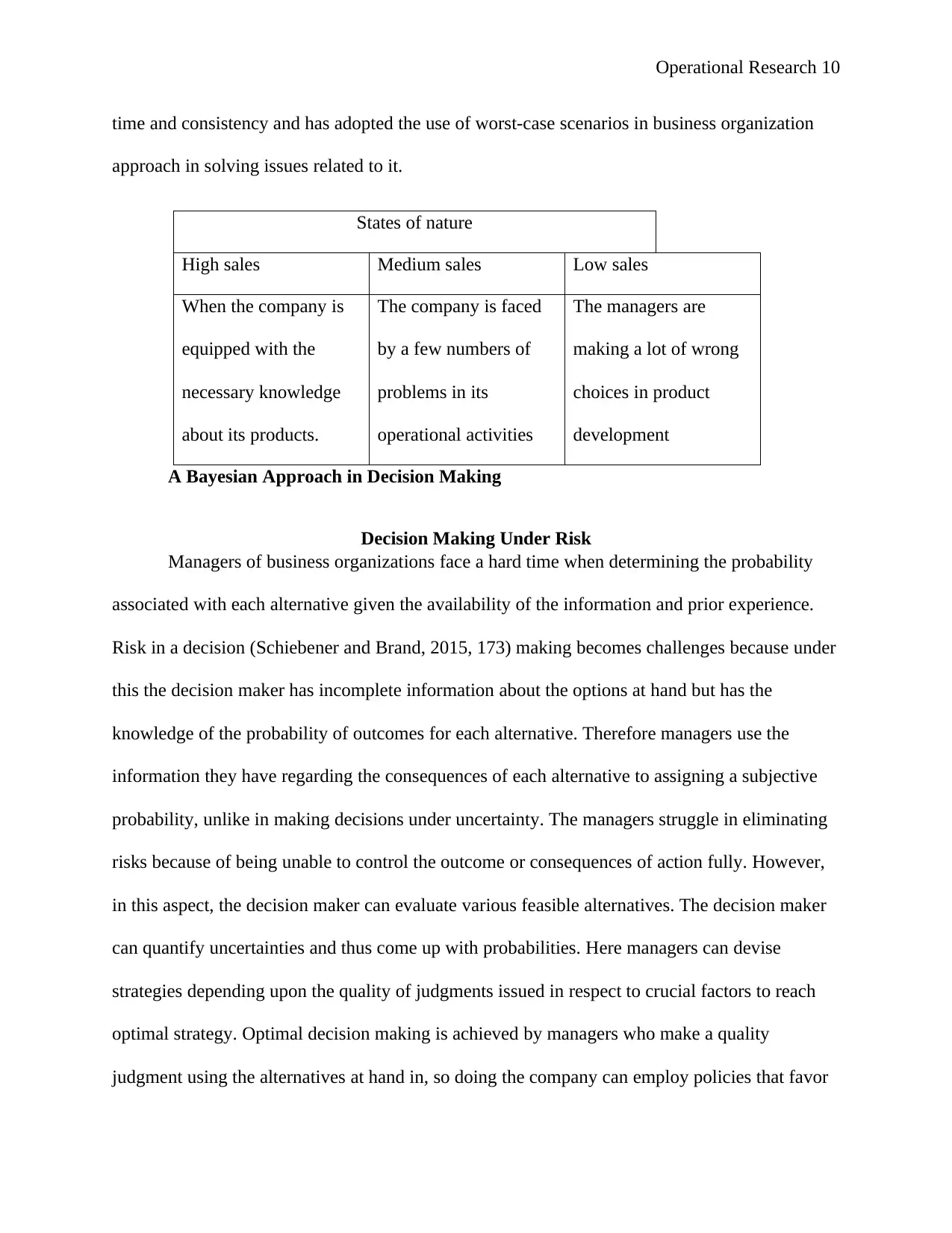
Operational Research 10
time and consistency and has adopted the use of worst-case scenarios in business organization
approach in solving issues related to it.
States of nature
High sales Medium sales Low sales
When the company is
equipped with the
necessary knowledge
about its products.
The company is faced
by a few numbers of
problems in its
operational activities
The managers are
making a lot of wrong
choices in product
development
A Bayesian Approach in Decision Making
Decision Making Under Risk
Managers of business organizations face a hard time when determining the probability
associated with each alternative given the availability of the information and prior experience.
Risk in a decision (Schiebener and Brand, 2015, 173) making becomes challenges because under
this the decision maker has incomplete information about the options at hand but has the
knowledge of the probability of outcomes for each alternative. Therefore managers use the
information they have regarding the consequences of each alternative to assigning a subjective
probability, unlike in making decisions under uncertainty. The managers struggle in eliminating
risks because of being unable to control the outcome or consequences of action fully. However,
in this aspect, the decision maker can evaluate various feasible alternatives. The decision maker
can quantify uncertainties and thus come up with probabilities. Here managers can devise
strategies depending upon the quality of judgments issued in respect to crucial factors to reach
optimal strategy. Optimal decision making is achieved by managers who make a quality
judgment using the alternatives at hand in, so doing the company can employ policies that favor
time and consistency and has adopted the use of worst-case scenarios in business organization
approach in solving issues related to it.
States of nature
High sales Medium sales Low sales
When the company is
equipped with the
necessary knowledge
about its products.
The company is faced
by a few numbers of
problems in its
operational activities
The managers are
making a lot of wrong
choices in product
development
A Bayesian Approach in Decision Making
Decision Making Under Risk
Managers of business organizations face a hard time when determining the probability
associated with each alternative given the availability of the information and prior experience.
Risk in a decision (Schiebener and Brand, 2015, 173) making becomes challenges because under
this the decision maker has incomplete information about the options at hand but has the
knowledge of the probability of outcomes for each alternative. Therefore managers use the
information they have regarding the consequences of each alternative to assigning a subjective
probability, unlike in making decisions under uncertainty. The managers struggle in eliminating
risks because of being unable to control the outcome or consequences of action fully. However,
in this aspect, the decision maker can evaluate various feasible alternatives. The decision maker
can quantify uncertainties and thus come up with probabilities. Here managers can devise
strategies depending upon the quality of judgments issued in respect to crucial factors to reach
optimal strategy. Optimal decision making is achieved by managers who make a quality
judgment using the alternatives at hand in, so doing the company can employ policies that favor
Paraphrase This Document
Need a fresh take? Get an instant paraphrase of this document with our AI Paraphraser
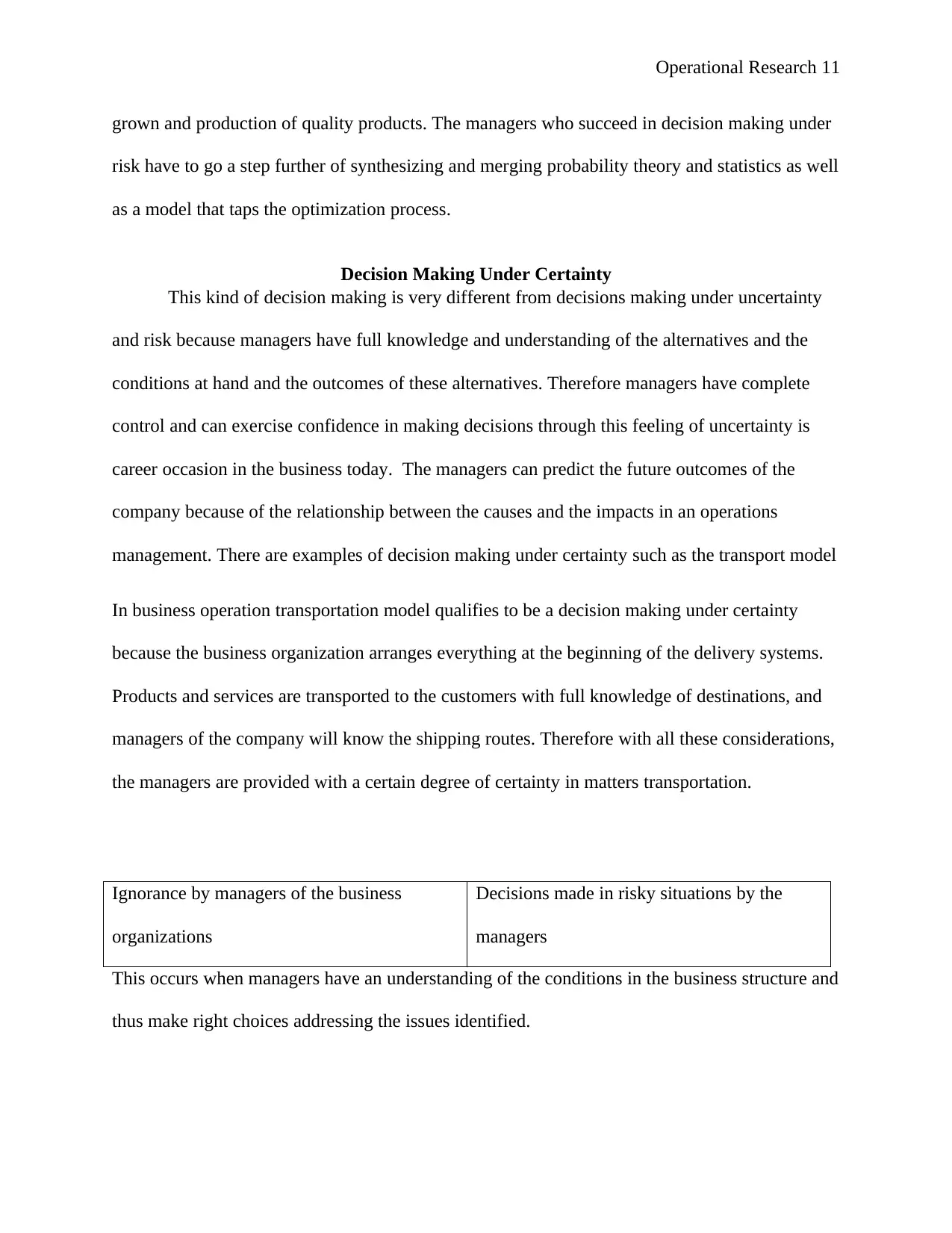
Operational Research 11
grown and production of quality products. The managers who succeed in decision making under
risk have to go a step further of synthesizing and merging probability theory and statistics as well
as a model that taps the optimization process.
Decision Making Under Certainty
This kind of decision making is very different from decisions making under uncertainty
and risk because managers have full knowledge and understanding of the alternatives and the
conditions at hand and the outcomes of these alternatives. Therefore managers have complete
control and can exercise confidence in making decisions through this feeling of uncertainty is
career occasion in the business today. The managers can predict the future outcomes of the
company because of the relationship between the causes and the impacts in an operations
management. There are examples of decision making under certainty such as the transport model
In business operation transportation model qualifies to be a decision making under certainty
because the business organization arranges everything at the beginning of the delivery systems.
Products and services are transported to the customers with full knowledge of destinations, and
managers of the company will know the shipping routes. Therefore with all these considerations,
the managers are provided with a certain degree of certainty in matters transportation.
Ignorance by managers of the business
organizations
Decisions made in risky situations by the
managers
This occurs when managers have an understanding of the conditions in the business structure and
thus make right choices addressing the issues identified.
grown and production of quality products. The managers who succeed in decision making under
risk have to go a step further of synthesizing and merging probability theory and statistics as well
as a model that taps the optimization process.
Decision Making Under Certainty
This kind of decision making is very different from decisions making under uncertainty
and risk because managers have full knowledge and understanding of the alternatives and the
conditions at hand and the outcomes of these alternatives. Therefore managers have complete
control and can exercise confidence in making decisions through this feeling of uncertainty is
career occasion in the business today. The managers can predict the future outcomes of the
company because of the relationship between the causes and the impacts in an operations
management. There are examples of decision making under certainty such as the transport model
In business operation transportation model qualifies to be a decision making under certainty
because the business organization arranges everything at the beginning of the delivery systems.
Products and services are transported to the customers with full knowledge of destinations, and
managers of the company will know the shipping routes. Therefore with all these considerations,
the managers are provided with a certain degree of certainty in matters transportation.
Ignorance by managers of the business
organizations
Decisions made in risky situations by the
managers
This occurs when managers have an understanding of the conditions in the business structure and
thus make right choices addressing the issues identified.
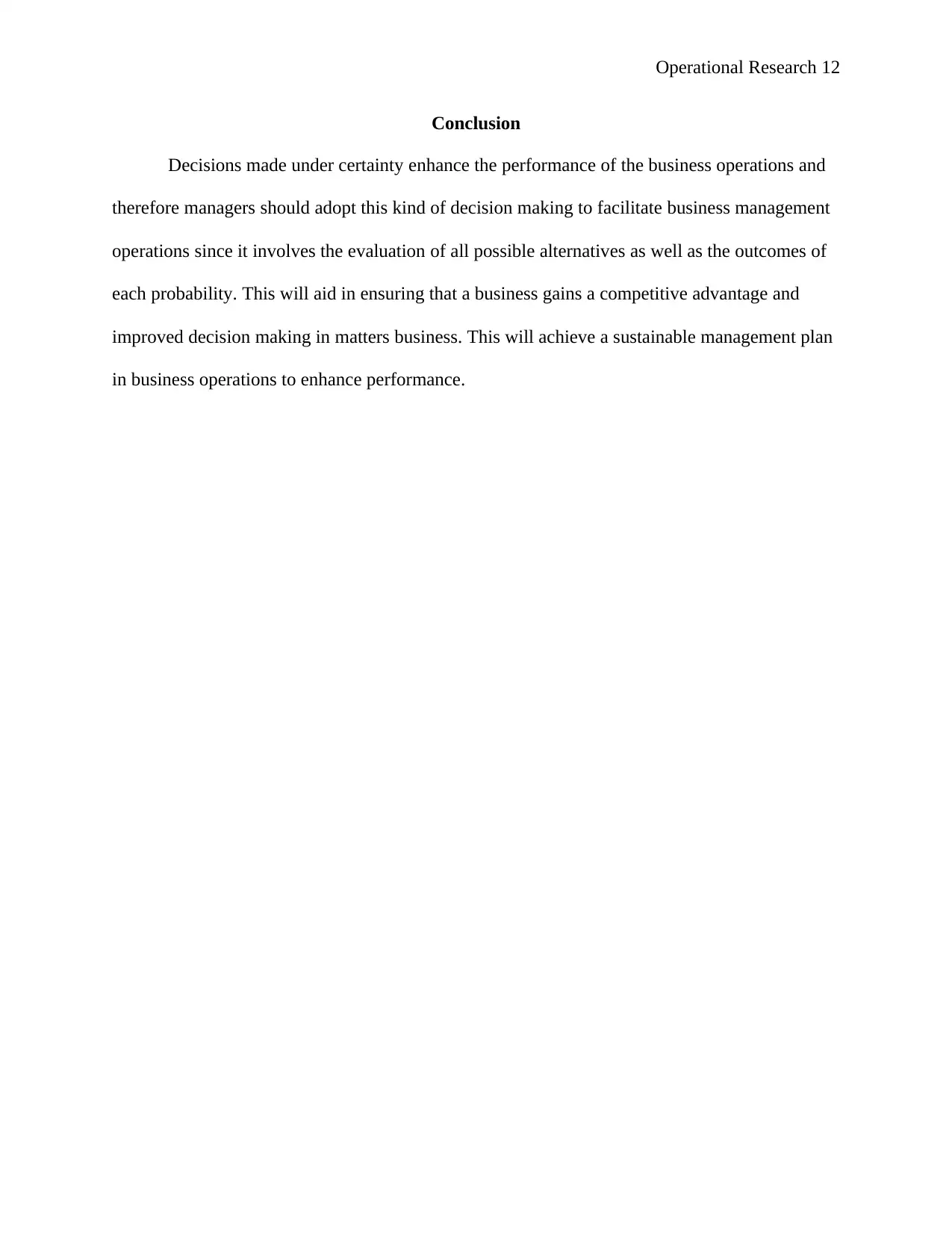
Operational Research 12
Conclusion
Decisions made under certainty enhance the performance of the business operations and
therefore managers should adopt this kind of decision making to facilitate business management
operations since it involves the evaluation of all possible alternatives as well as the outcomes of
each probability. This will aid in ensuring that a business gains a competitive advantage and
improved decision making in matters business. This will achieve a sustainable management plan
in business operations to enhance performance.
Conclusion
Decisions made under certainty enhance the performance of the business operations and
therefore managers should adopt this kind of decision making to facilitate business management
operations since it involves the evaluation of all possible alternatives as well as the outcomes of
each probability. This will aid in ensuring that a business gains a competitive advantage and
improved decision making in matters business. This will achieve a sustainable management plan
in business operations to enhance performance.
⊘ This is a preview!⊘
Do you want full access?
Subscribe today to unlock all pages.

Trusted by 1+ million students worldwide
1 out of 15
Related Documents
Your All-in-One AI-Powered Toolkit for Academic Success.
+13062052269
info@desklib.com
Available 24*7 on WhatsApp / Email
![[object Object]](/_next/static/media/star-bottom.7253800d.svg)
Unlock your academic potential
Copyright © 2020–2025 A2Z Services. All Rights Reserved. Developed and managed by ZUCOL.



